parking brake TOYOTA iQ EV 2013 Owners Manual (in English)
[x] Cancel search | Manufacturer: TOYOTA, Model Year: 2013, Model line: iQ EV, Model: TOYOTA iQ EV 2013Pages: 444, PDF Size: 7.34 MB
Page 3 of 444
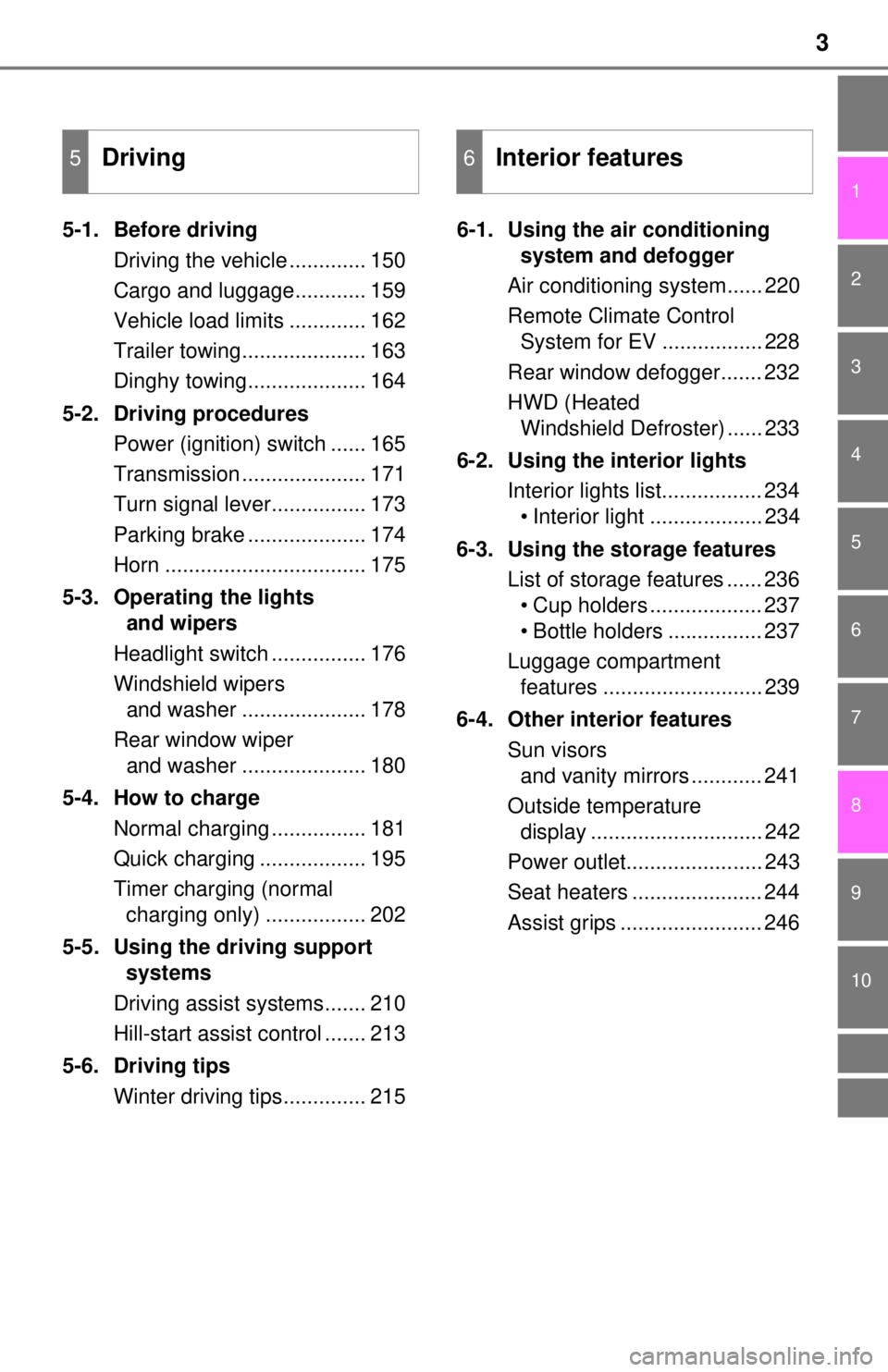
3
9 8
7
6
5
4
3
10
1
2
5-1. Before drivingDriving the vehicle ............. 150
Cargo and luggage............ 159
Vehicle load limits ............. 162
Trailer towing..................... 163
Dinghy towing.................... 164
5-2. Driving procedures Power (ignition) switch ...... 165
Transmission ..................... 171
Turn signal lever................ 173
Parking brake .................... 174
Horn .................................. 175
5-3. Operating the lights and wipers
Headlight switch ................ 176
Windshield wipers and washer ..................... 178
Rear window wiper and washer ..................... 180
5-4. How to charge Normal charging ................ 181
Quick charging .................. 195
Timer charging (normal charging only) ................. 202
5-5. Using the driving support systems
Driving assist systems....... 210
Hill-start assist control ....... 213
5-6. Driving tips Winter driving tips.............. 215 6-1. Using the air conditioning
system and defogger
Air conditioning system...... 220
Remote Climate Control System for EV ................. 228
Rear window defogger....... 232
HWD (Heated Windshield Defroster) ...... 233
6-2. Using the interior lights Interior lights list................. 234• Interior light ................... 234
6-3. Using the storage features List of storage features ...... 236• Cup holders ................... 237
• Bottle holders ................ 237
Luggage compartment features ........................... 239
6-4. Other interior features Sun visors and vanity mirrors ............ 241
Outside temperature display ............................. 242
Power outlet....................... 243
Seat heaters ...................... 244
Assist grips ........................ 246
5Driving6Interior features
Page 15 of 444
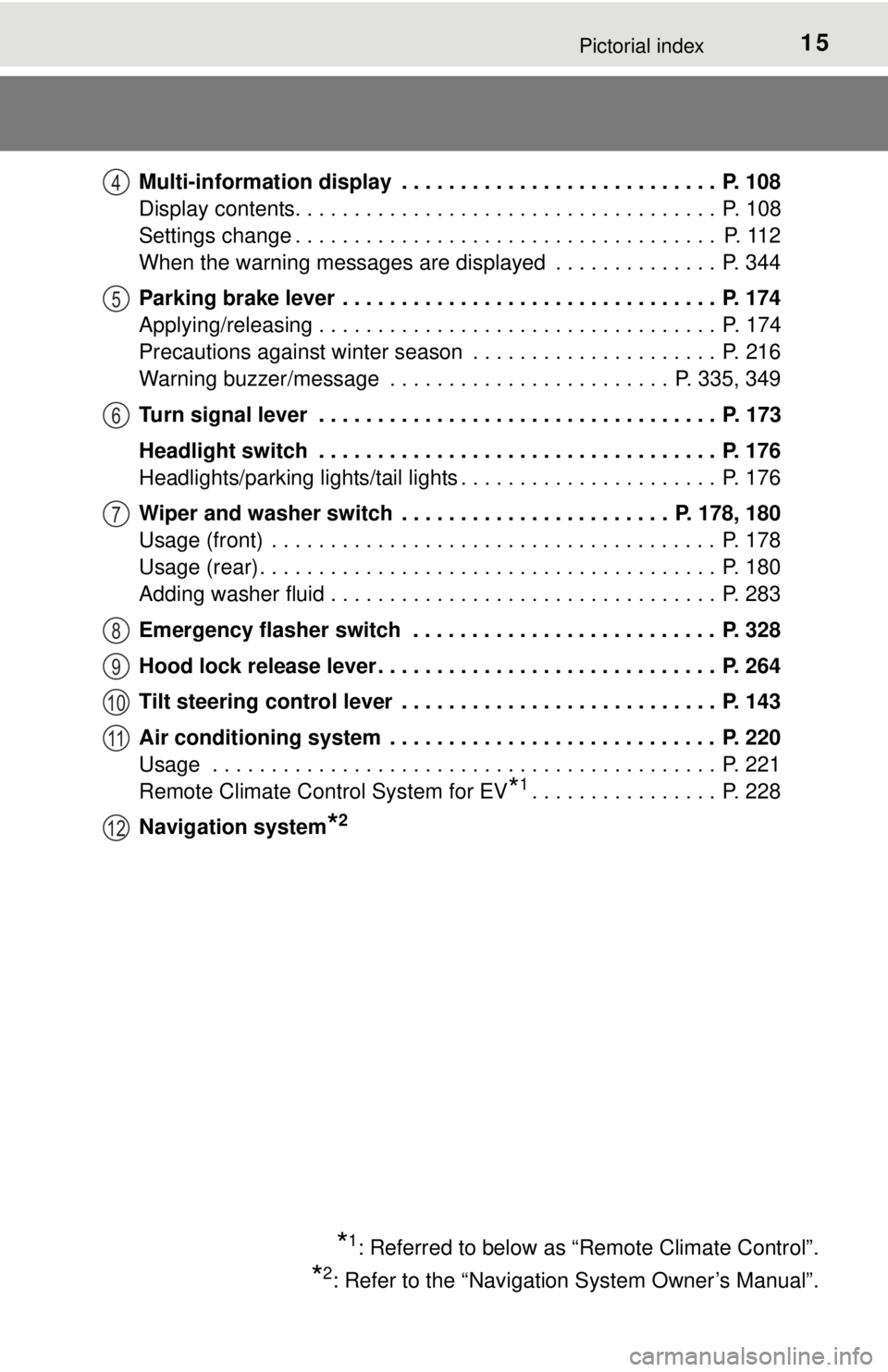
15Pictorial index
Multi-information display . . . . . . . . . . . . . . . . . . . . . . . . . . . P. 108
Display contents. . . . . . . . . . . . . . . . . . . . . . . . . . . . . . . . . . . . P. 108
Settings change . . . . . . . . . . . . . . . . . . . . . . . . . . . . . . . . . . . . P. 112
When the warning messages are displayed . . . . . . . . . . . . . . P. 344
Parking brake lever . . . . . . . . . . . . . . . . . . . . . . . . . . . . . . . . P. 174
Applying/releasing . . . . . . . . . . . . . . . . . . . . . . . . . . . . . . . . . . P. 174
Precautions against winter season . . . . . . . . . . . . . . . . . . . . . P. 216
Warning buzzer/message . . . . . . . . . . . . . . . . . . . . . . . . P. 335, 349
Turn signal lever . . . . . . . . . . . . . . . . . . . . . . . . . . . . . . . . . . P. 173
Headlight switch . . . . . . . . . . . . . . . . . . . . . . . . . . . . . . . . . . P. 176
Headlights/parking lights/tail lights . . . . . . . . . . . . . . . . . . . . . . P. 176
Wiper and washer switch . . . . . . . . . . . . . . . . . . . . . . . P. 178, 180
Usage (front) . . . . . . . . . . . . . . . . . . . . . . . . . . . . . . . . . . . . . . P. 178
Usage (rear) . . . . . . . . . . . . . . . . . . . . . . . . . . . . . . . . . . . . . . . P. 180
Adding washer fluid . . . . . . . . . . . . . . . . . . . . . . . . . . . . . . . . . P. 283
Emergency flasher switch . . . . . . . . . . . . . . . . . . . . . . . . . . P. 328
Hood lock release lever. . . . . . . . . . . . . . . . . . . . . . . . . . . . . P. 264
Tilt steering control lever . . . . . . . . . . . . . . . . . . . . . . . . . . . P. 143
Air conditioning system . . . . . . . . . . . . . . . . . . . . . . . . . . . . P. 220
Usage . . . . . . . . . . . . . . . . . . . . . . . . . . . . . . . . . . . . . . . . . . . P. 221
Remote Climate Control System for EV
*1. . . . . . . . . . . . . . . . P. 228
Navigation system
*2
*1: Referred to below as “Remote Climate Control”.
*2: Refer to the “Navigation System Owner’s Manual”.
4
5
6
7
8
9
10
11
12
Page 77 of 444
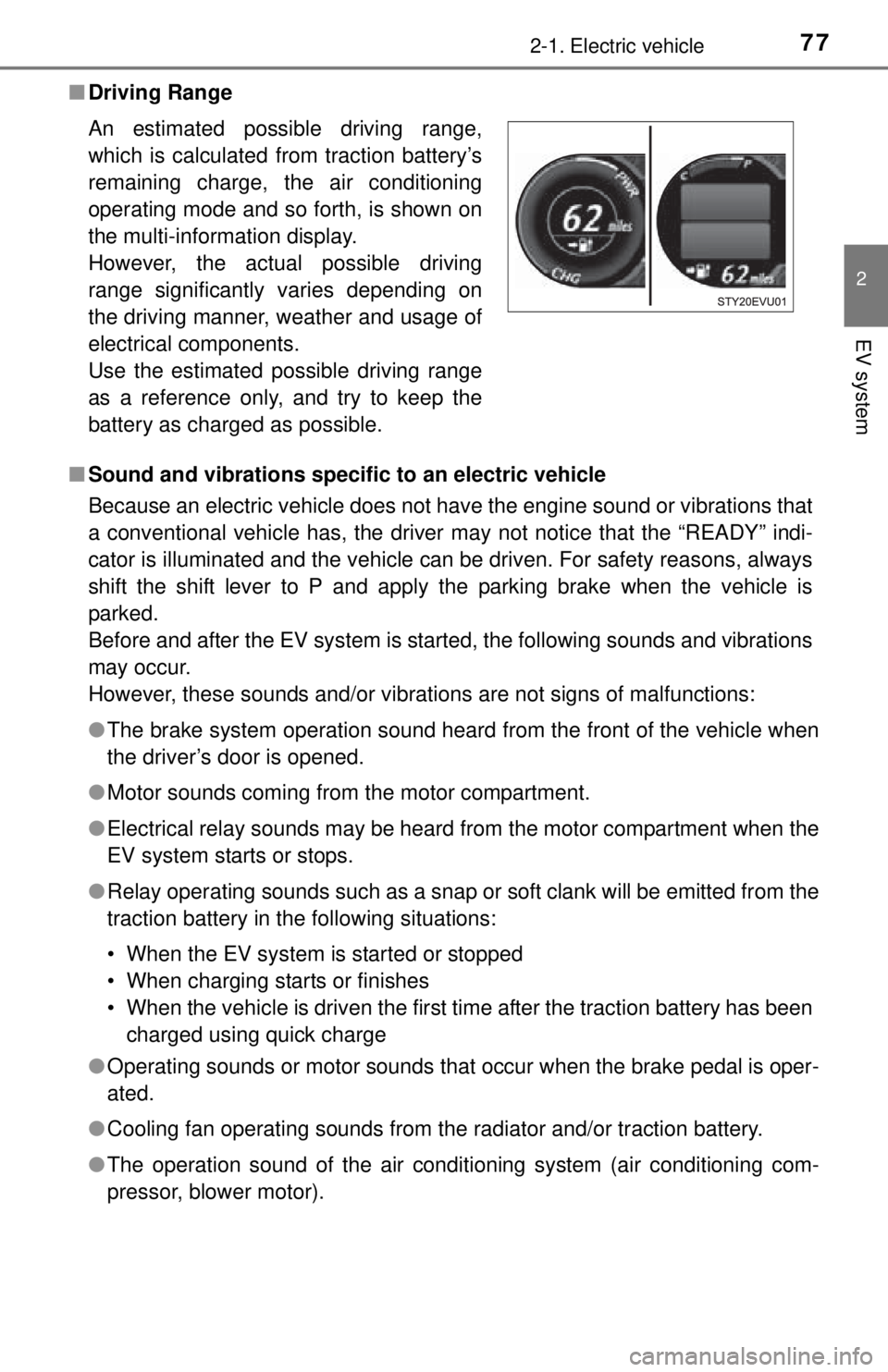
772-1. Electric vehicle
2
EV system
■Driving Range
■ Sound and vibrations speci fic to an electric vehicle
Because an electric vehicle does not have the engine sound or vibrations that
a conventional vehicle has, the driver may not notice that the “READY” indi-
cator is illuminated and the vehicle can be driven. For safety reasons, always
shift the shift lever to P and apply the parking brake when the vehicle is
parked.
Before and after the EV system is started, the following sounds and vibrations
may occur.
However, these sounds and/or vibrations are not signs of malfunctions:
● The brake system operation sound heard from the front of the vehicle when
the driver’s door is opened.
● Motor sounds coming from the motor compartment.
● Electrical relay sounds may be heard from the motor compartment when the
EV system starts or stops.
● Relay operating sounds such as a snap or soft clank will be emitted from the
traction battery in the following situations:
• When the EV system is started or stopped
• When charging starts or finishes
• When the vehicle is driven the first time after the traction battery has been
charged using quick charge
● Operating sounds or motor sounds that occur when the brake pedal is oper-
ated.
● Cooling fan operating sounds from the radiator and/or traction battery.
● The operation sound of the air conditioning system (air conditioning com-
pressor, blower motor).
An estimated possible driving range,
which is calculated from traction battery’s
remaining charge, the air conditioning
operating mode and so forth, is shown on
the multi-information display.
However, the actual possible driving
range significantly varies depending on
the driving manner, weather and usage of
electrical components.
Use the estimated possible driving range
as a reference only, and try to keep the
battery as charged as possible.
Page 82 of 444

822-1. Electric vehicle
CAUTION
■Road accident cautions
Follow the instructions described below to reduce the risk of death or seri-
ous injury, and immediately contact your Scion dealer:
● Stop the vehicle in a safe place, apply the parking brake while depressing
the brake pedal, shift the shift lever to P and turn the EV system off.
Then, slowly release the brake pedal.
● Do not touch the high voltage parts, cables (orange) and connectors.
● If electric wires are exposed inside or outside your vehicle, an electric
shock may occur. Never touch exposed electric wires.
● Do not touch the traction battery if liquid is leaking from or adhered to it.
If electrolyte (Organic Carbonate-based electrolyte) from the traction bat-
tery comes into contact with the eyes or skin, it could cause blindness or
skin wounds. In the unlikely event that it comes into contact with the eyes
or skin, wash it off immediately with a large amount of water, and seek
immediate medical attention.
● If electrolyte is leaking from the traction battery, do not approach the vehi-
cle.
Even in the unlikely event that the traction battery has been damaged, the
internal construction of the battery will prevent a large amount of electro-
lyte from leaking out. However, if electrolyte leaks, vapors will be emitted.
These vapors are an irritant to skin and eyes and could cause acute poi-
soning if inhaled.
● Do not bring burning or high-temperat ure items close to the electrolyte.
The electrolyte may ignite and cause a fire.
● If a fire occurs in the electric vehicle, leave the vehicle as soon as possi-
ble. Never use a fire extinguisher that is not meant for electrical fires.
Using even a small amount of water may be dangerous.
● If your vehicle needs to be towed, do so with the front wheels raised. If the
wheels connected to the electric motor (traction motor) are on the ground
when towing, the motor may continue to generate electricity. This may
cause an electricity leakage leading to a fire. ( P. 330)
Page 93 of 444
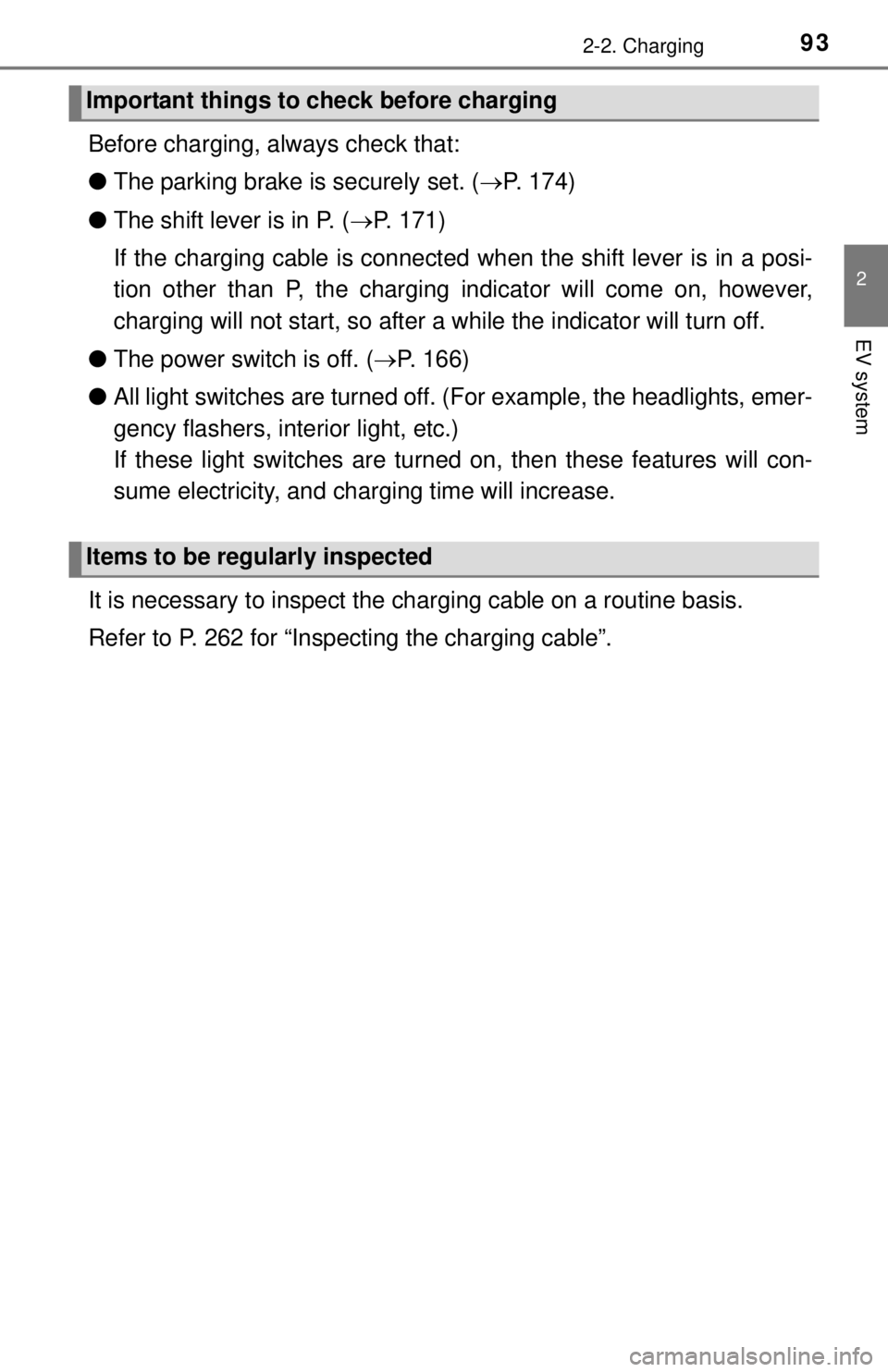
932-2. Charging
2
EV system
Before charging, always check that:
●The parking brake is securely set. ( P. 174)
● The shift lever is in P. ( P. 171)
If the charging cable is connected when the shift lever is in a posi-
tion other than P, the charging in dicator will come on, however,
charging will not start, so after a while the indicator will turn off.
● The power switch is off. ( P. 166)
● All light switches are turned off. (F or example, the headlights, emer-
gency flashers, inte rior light, etc.)
If these light switches are turned on, then th ese features will con-
sume electricity, and charging time will increase.
It is necessary to inspect the charging cable on a routine basis.
Refer to P. 262 for “Inspec ting the charging cable”.
Important things to check before charging
Items to be regularly inspected
Page 112 of 444
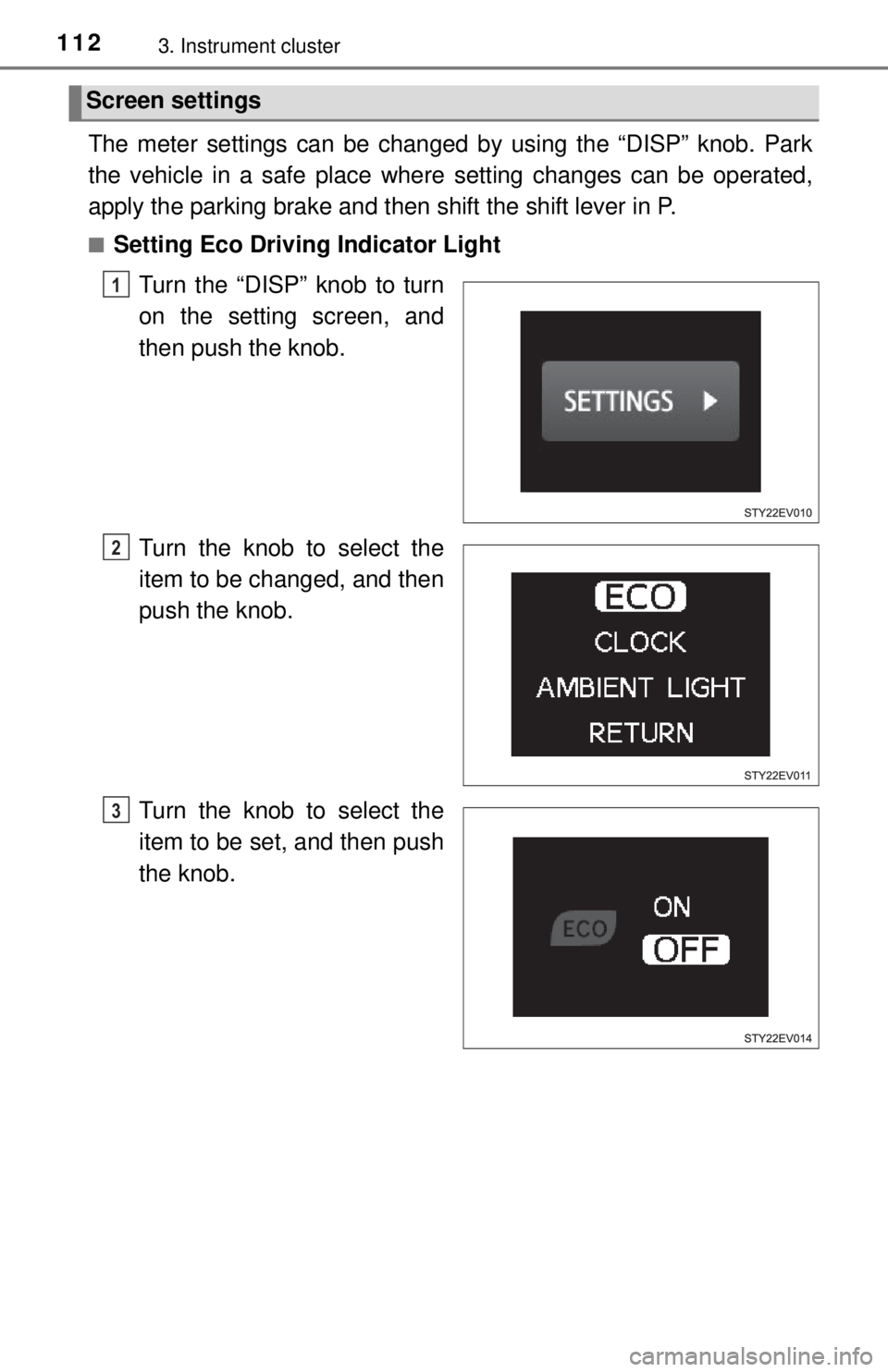
1123. Instrument cluster
The meter settings can be changed by using the “DISP” knob. Park
the vehicle in a safe place where setting changes can be operated,
apply the parking brake and then shift the shift lever in P.
■Setting Eco Driving Indicator LightTurn the “DISP” knob to turn
on the setting screen, and
then push the knob.
Turn the knob to select the
item to be changed, and then
push the knob.
Turn the knob to select the
item to be set, and then push
the knob.
Screen settings
1
2
3
Page 141 of 444
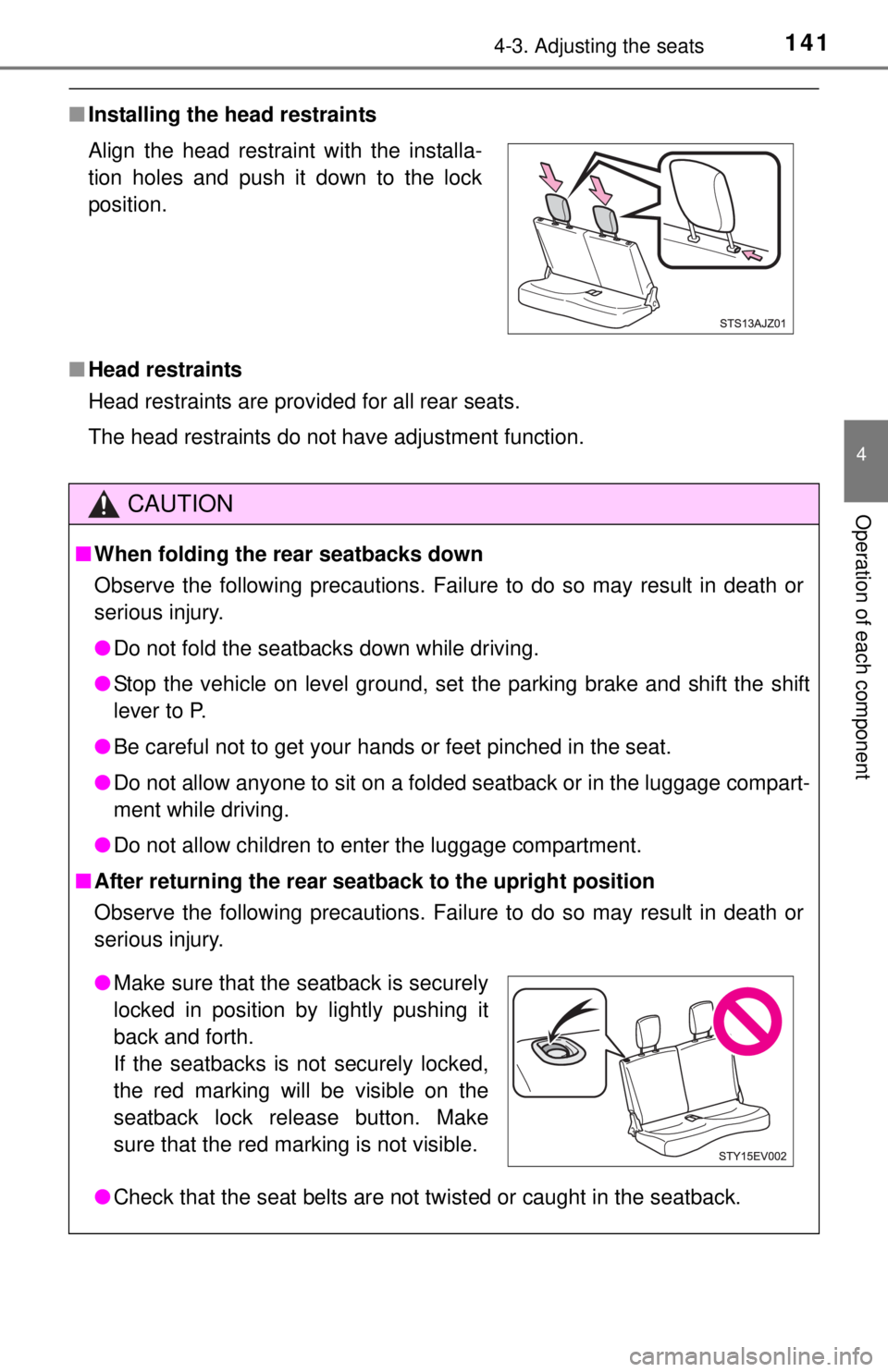
1414-3. Adjusting the seats
4
Operation of each component
■Installing the head restraints
■ Head restraints
Head restraints are provided for all rear seats.
The head restraints do not have adjustment function. Align the head restraint with the installa-
tion holes and push it down to the lock
position.
CAUTION
■When folding the rear seatbacks down
Observe the following precautions. Failure to do so may result in death or
serious injury.
● Do not fold the seatbacks down while driving.
● Stop the vehicle on level ground, set the parking brake and shift the shift
lever to P.
● Be careful not to get your hands or feet pinched in the seat.
● Do not allow anyone to sit on a folded seatback or in the luggage compart-
ment while driving.
● Do not allow children to enter the luggage compartment.
■ After returning the rear seatback to the upright position
Observe the following precautions. Failure to do so may result in death or
serious injury.
● Check that the seat belts are not twisted or caught in the seatback.
●Make sure that the seatback is securely
locked in position by lightly pushing it
back and forth.
If the seatbacks is not securely locked,
the red marking will be visible on the
seatback lock release button. Make
sure that the red marking is not visible.
Page 149 of 444

149
5Driving
5-1. Before drivingDriving the vehicle ............. 150
Cargo and luggage ........... 159
Vehicle load limits ............. 162
Trailer towing..................... 163
Dinghy towing ................... 164
5-2. Driving procedures Power (ignition) switch ...... 165
Transmission ..................... 171
Turn signal lever................ 173
Parking brake .................... 174
Horn .................................. 175
5-3. Operating the lights and wipers
Headlight switch ................ 176
Windshield wipers and washer ..................... 178
Rear window wiper and washer ............................ 180
5-4. How to charge Normal charging ................ 181
Quick charging .................. 195
Timer charging (normal charging only) ................. 202 5-5. Using the driving support
systems
Driving assist systems ...... 210
Hill-start assist control ....... 213
5-6. Driving tips Winter driving tips ............. 215
Page 150 of 444
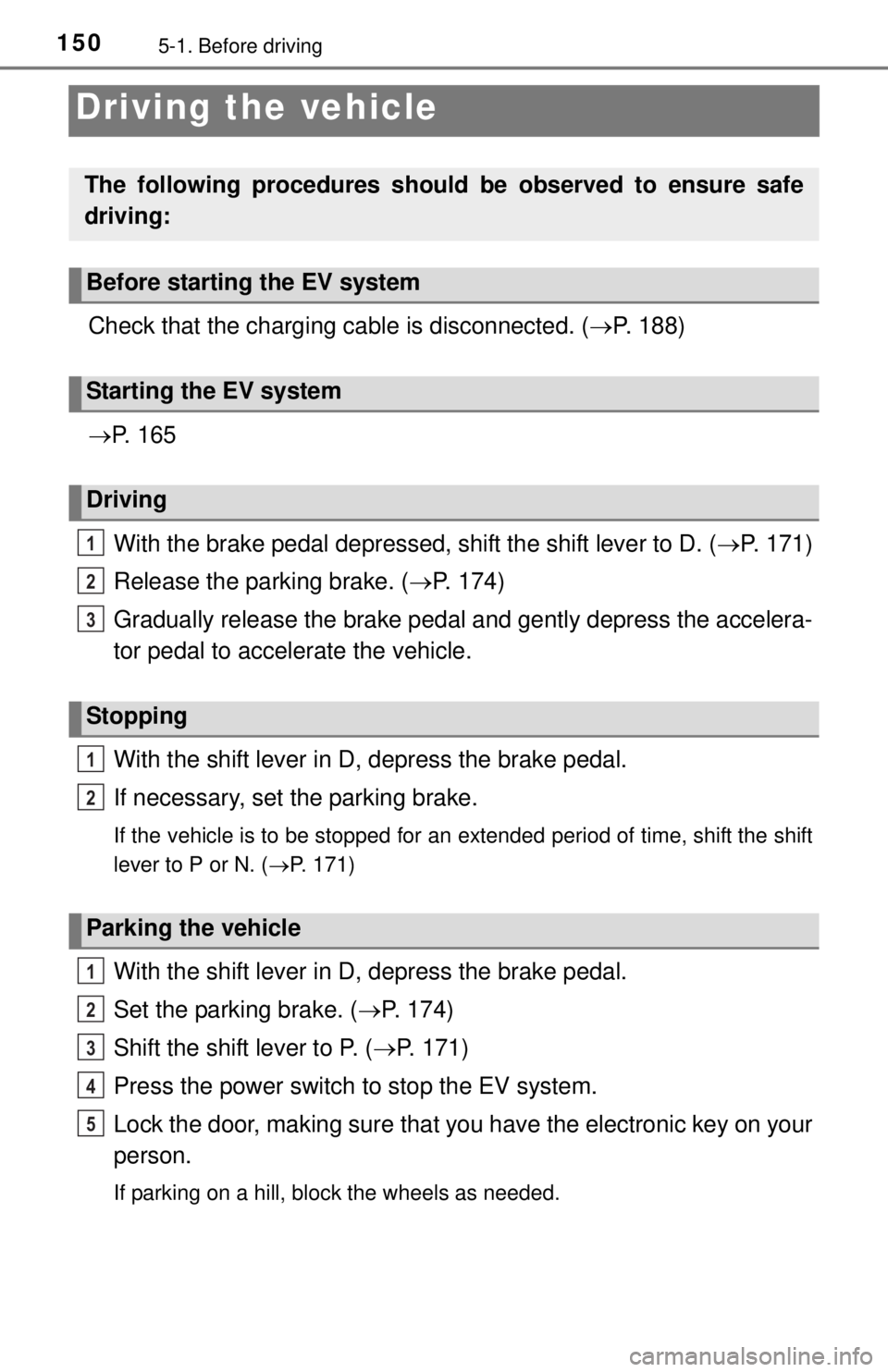
1505-1. Before driving
Driving the vehicle
Check that the charging cable is disconnected. (P. 188)
P. 1 6 5
With the brake pedal depressed, shift the shift lever to D. ( P. 171)
Release the parking brake. ( P. 174)
Gradually release the brake pedal and gently depress the accelera-
tor pedal to accelerate the vehicle.
With the shift lever in D, depress the brake pedal.
If necessary, set the parking brake.
If the vehicle is to be stopped for an extended period of time, shift the shift
lever to P or N. ( P. 171)
With the shift lever in D, depress the brake pedal.
Set the parking brake. ( P. 174)
Shift the shift lever to P. ( P. 171)
Press the power switch to stop the EV system.
Lock the door, making sure that you have the electronic key on your
person.
If parking on a hill, block the wheels as needed.
The following procedures should be observed to ensure safe
driving:
Before starting the EV system
Starting the EV system
Driving
Stopping
Parking the vehicle
1
2
3
1
2
1
2
3
4
5
Page 151 of 444
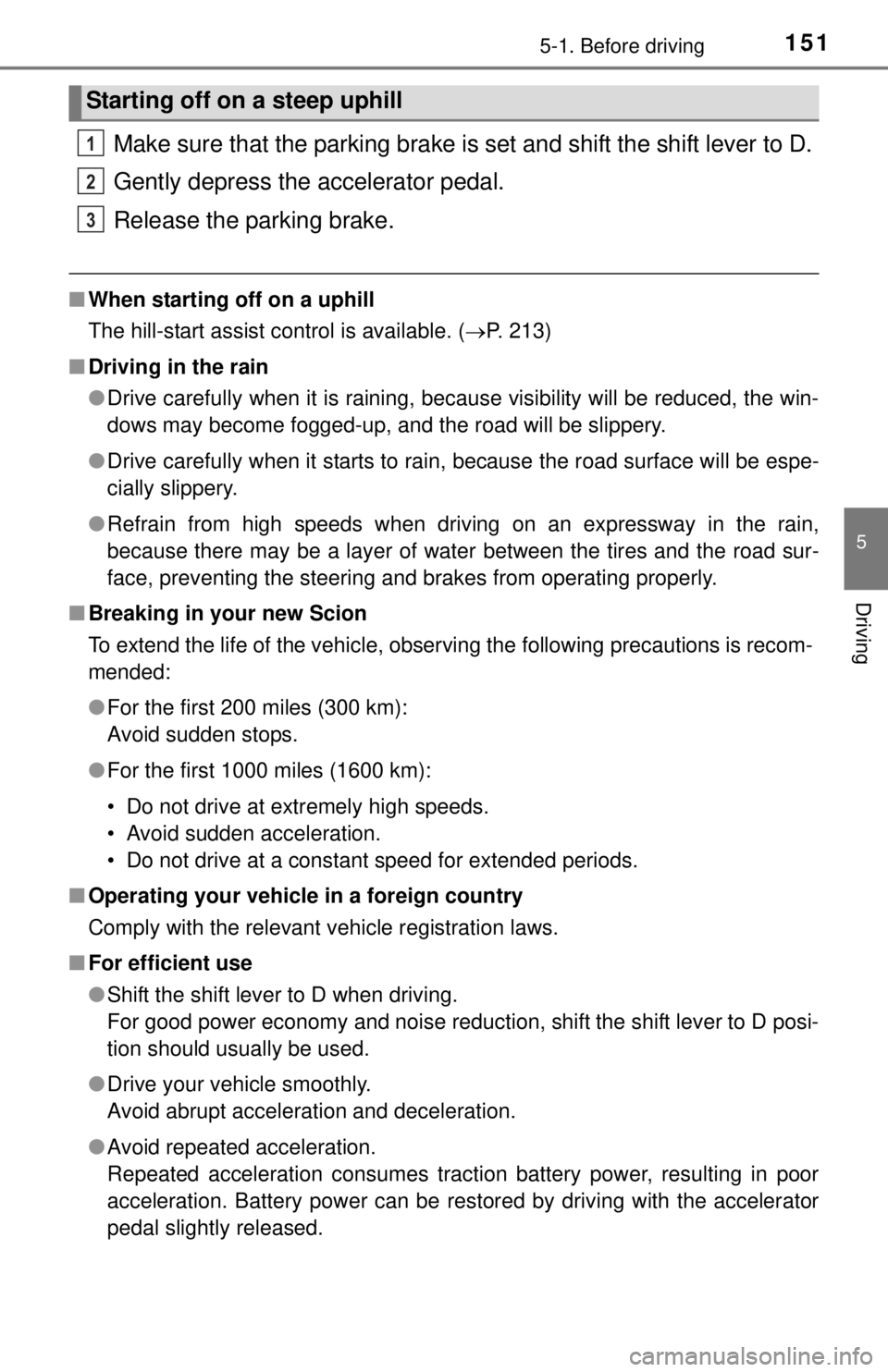
1515-1. Before driving
5
Driving
Make sure that the parking brake is set and shift the shift lever to D.
Gently depress the accelerator pedal.
Release the parking brake.
■When starting off on a uphill
The hill-start assist control is available. ( P. 213)
■ Driving in the rain
●Drive carefully when it is raining, because visibility will be reduced, the win-
dows may become fogged-up, and the road will be slippery.
● Drive carefully when it starts to rain, because the road surface will be espe-
cially slippery.
● Refrain from high speeds when driving on an expressway in the rain,
because there may be a layer of water between the tires and the road sur-
face, preventing the steering and brakes from operating properly.
■ Breaking in your new Scion
To extend the life of the vehicle, observing the following precautions is recom-
mended:
●For the first 200 miles (300 km):
Avoid sudden stops.
● For the first 1000 miles (1600 km):
• Do not drive at extremely high speeds.
• Avoid sudden acceleration.
• Do not drive at a constant speed for extended periods.
■ Operating your vehicle in a foreign country
Comply with the relevant vehicle registration laws.
■ For efficient use
●Shift the shift lever to D when driving.
For good power economy and noise reduction, shift the shift lever to D posi-
tion should usually be used.
● Drive your vehicle smoothly.
Avoid abrupt acceleration and deceleration.
● Avoid repeated acceleration.
Repeated acceleration consumes traction battery power, resulting in poor
acceleration. Battery power can be restored by driving with the accelerator
pedal slightly released.
Starting off on a steep uphill
1
2
3